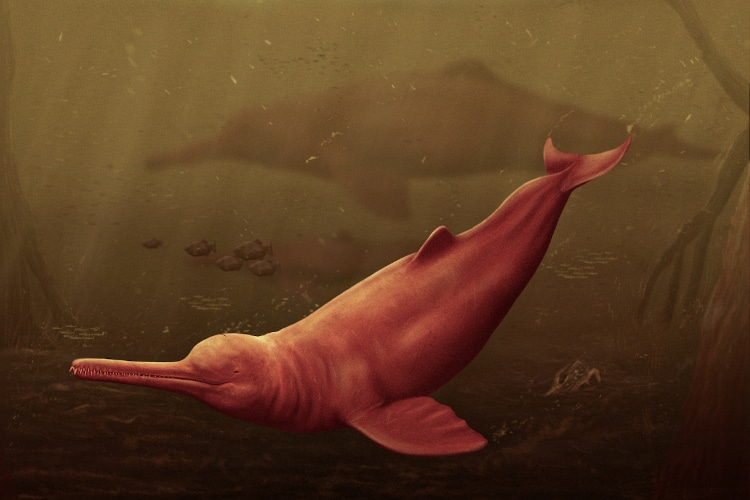
Artistic reconstruction of Pebanista yacuruna (Photo: Jaime Bran via Wikimedia Commons, CC BY 4.0)
About 16 million years ago, the Peruvian Amazon rainforest was covered by a massive lake known as Pebas, one of the most biodiverse ecosystems to ever exist on Earth. Among the species that called it home was the largest freshwater dolphin ever—a creature whose existence remained in the dark until 2018, when paleontologist Aldo Benites-Palomino spotted a fossilized jaw bone during a field expedition around Peru’s Napo River.
“As soon as I recognized it, I saw the teeth sockets. I screamed, ‘This is a dolphin.’ We could not believe it,” Benites-Palomino told The Guardian. At first, he figured the dolphin must have been an ancestor to the contemporary Amazon river pink dolphins found in South America. However, further research made it clear that not only was it a completely different species that has since gone extinct, but its closest relatives live halfway across the world. Specifically, in the Ganges and Indus rivers of South Asia, some 6,200 miles away.
“It’s difficult to find fossils from this era, since they’re only accessible during the dry season when the Amazon rivers are low enough to expose rocks from the past,” says Benites-Palomino on TikTok.
The newly discovered species was named Pebanista yacuruna in honor of the Yacuruna, of a mythical aquatic people believed to live in underwater cities throughout the Amazon basin. This creature could grow to up to 11.5 feet long, had small eyes, and a bony structure called a facial crest that allowed it to get around using echolocation. “For river dolphins, echolocation, or biosonar, is even more critical as the waters they inhabit are extremely muddy, which impedes their vision,” explained Gabriel Aguirre-Fernández, a University of Zurich researcher who also participated in this study.
It is believed that the Pebanista Yacuruna originally lived in the ocean before moving to freshwater habitats in search of new sources of food. And just like these dolphins evolved in ways that helped them thrive in their new environment, they may also hold the key to help the endangered fresh water dolphins of the world today, which see their ecosystems threatened by global warming and pollution.
“Around 11 to 12 million years ago, this mega-wetland system started to drain, giving way to the modern Amazon,” Benites-Palomino told New Scientist. “A lot of species disappeared at that moment, and that might also have been the fate of this giant dolphin.”
Today, this insightful fossil sits in the Museum of Natural History in Lima, Peru—an institution that saw Benites-Palomino start his career as a Research Associate. But his findings will go much further. “The finding of Pebanista in the Peruvian Amazon only reasserts one thing,” concludes Benites-Palomino. “Our fossils are rewriting the story of many animal groups.”
Aldo Benites-Palomino: Twitter | TikTok
h/t: [Smithsonian Magazine]
Related Articles:
Whale Thought To Have Gone Extinct Nearly 200 Years Ago Spotted off Coast of Massachusetts
Researchers Discover New Extinct Species of Mini Penguins That Lived 3 Million Years Ago
99-Million-Year-Old Baby Bird Feathers Study Sheds Light on Dinosaur Extinction
Company Creates Meatball From the Cells of an Extinct Woolly Mammoth
